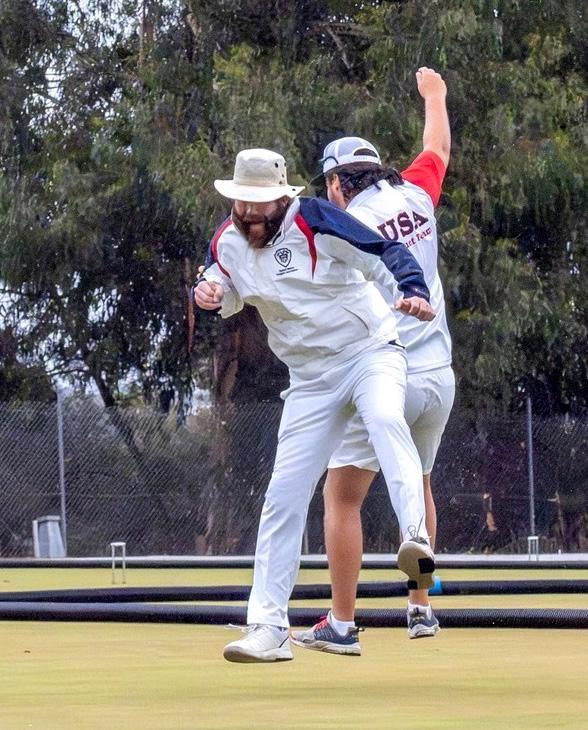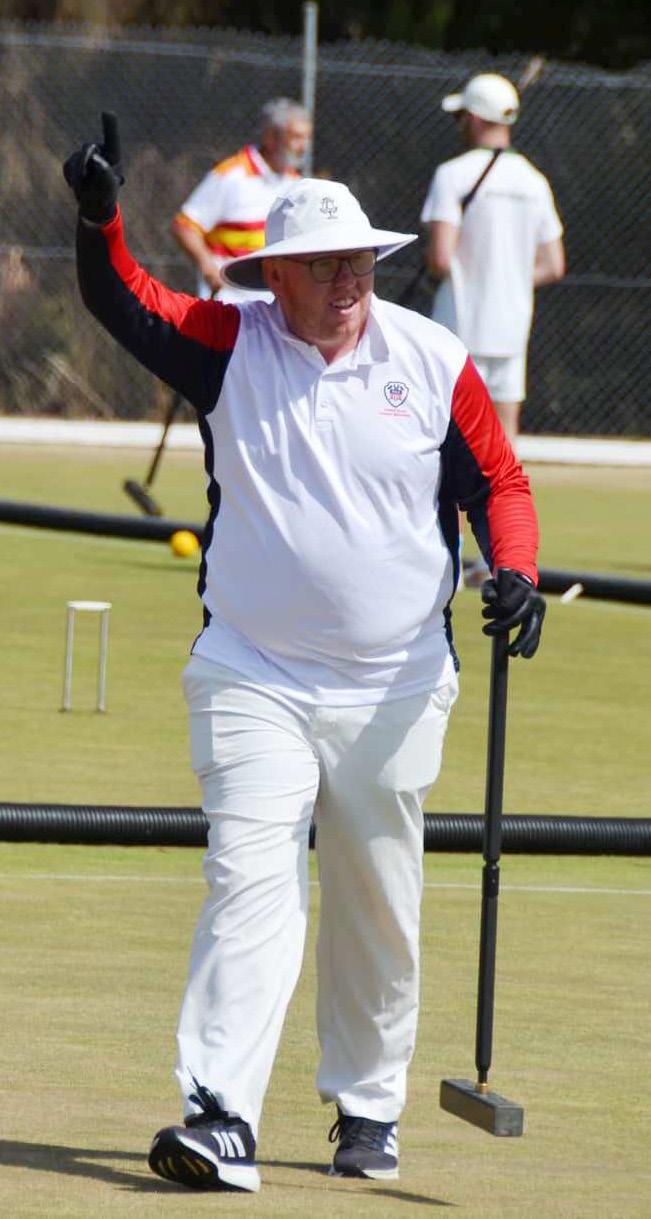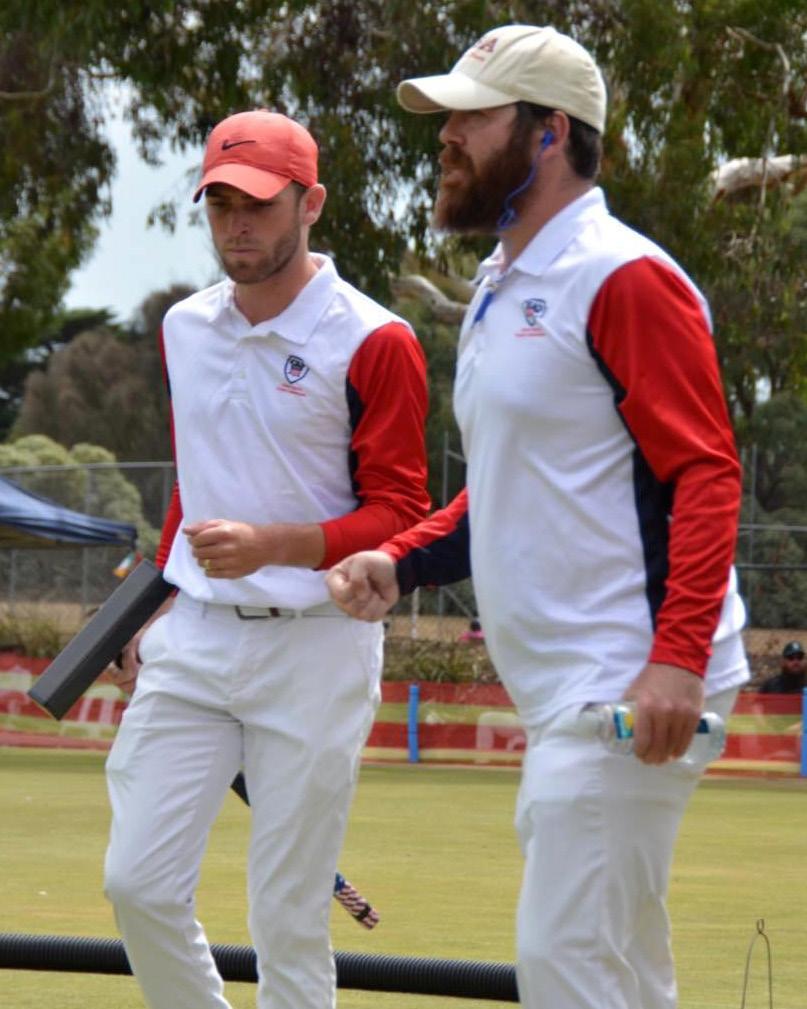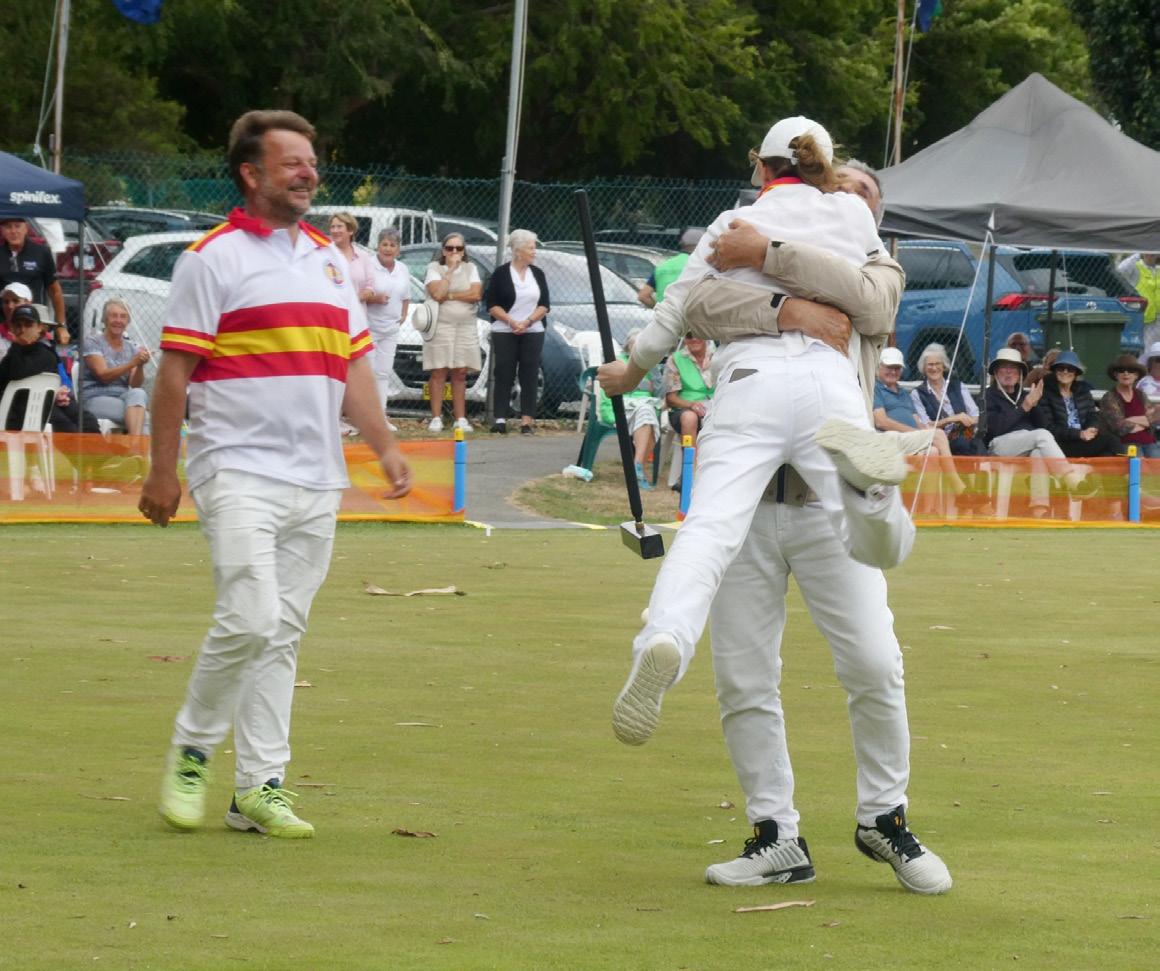
17 minute read
2025 Croquet News Volume 2: Team USA Wins Openshaw Shield
ON THE SHOULDERS OF GIANTS
IN A PERFORMANCE THAT CAPTURED THE ATTENTION OF GC FANS ACROSS THE WORLD, TEAM USA STORMED TO ITS FIRST-EVER WORLD CROQUET TITLE AT THE PFC MALLETS GOLF CROQUET WORLD TEAM CHAMPIONSHIP, DELIVERING A FLAWLESS 7-0 TEST VICTORY OVER PERENNIAL POWERHOUSE EGYPT IN THE FINAL AT THE NORTHERN TASMANIAN CROQUET CENTRE IN ST. LEONARDS, TASMANIA.
Held February 17-22, the American squad came into the event with a loaded roster that featured 2019 World Champion Ben Rothman, current World Champion Blake Fields, 2022 World Champion Matthew Essick, Tom Balding and Stephen Morgan. Throughout the six-day event, the team displayed top form across the lineup and, with a wealth of previous international experience, exuded a calm confidence all week.
Shortly after returning to the U.S., Rothman spoke about the achievement, saying, “It was pure joy. It was great fun. It was a little bit of a weight off the shoulders. We had great control and all we wanted to do was make sure that we didn’t give them any sort of opening because they were a fantastic team. So, with a big lead, we really wanted to shut the door.”
Essick added to the sentiment, saying, “Going to a lot of these team events over the years and coming up short … the first international world teams win for the United States is just a really big deal.”
A Strong Start
The team showed good form from the beginning as they notably went 3-0 in Block A with a 5-1 win over Spain on Day One, then defeated South Africa 5-1 on Day Two before closing out with a 4-2 victory over Egypt. That final block test saw the U.S. team fight out of an 0-2 hole as they lost both opening doubles matches before bouncing back to win all the singles matches.
Reflecting on the importance of that final block test, Rothman says, “We lost at Hoop 13 in both game threes of the doubles to start the test. The good news was we already had two test wins, so we knew we were making it out (of the block). But coming out and playing the number one (Australia from Block B) who had a couple of 6-0 wins would have been a lot harder than finishing the block by beating Egypt and getting whichever team was kind of scraping by. Rallying from those two losses at Hoop 13 in game three to win all the singles was huge because … we knew we could beat Egypt, but we hadn’t ever beaten Egypt.”

Meet the Defenders
For their efforts in winning Block A, Team USA was rewarded with a match against two-time defending champion New Zealand. Australia had scored a 4-2 victory over New Zealand in the first round of Block B play, but the proud New Zealand squad stayed in the hunt by soundly defeating England 5-1 and Ireland 6-0 to earn a trip to the knockout phase.
The semifinal battle with Team USA kicked off with a 1-1 split in the doubles matches. New Zealand’s Edmund Fordyce then claimed a 7-6, 7-5 win over Fields to push the defenders out to a 2-1 lead in a match that was featured on the livestream. But Essick then claimed a 7-3, 5-7, 7-5 win over Felix Webby to even the test at 2-2.
From there, Team USA amped up their game with Rothman getting a 7-6, 7-6 victory over Logan McCorkindale, which was followed by a 6-7, 7-6, 7-3 win for Balding over Levi Franks. Essick pushed the test score to 5-2 by defeating McCorkindale 7-5, 7-4 in the last match of the day for the test.
Needing two wins to clinch the test the following day, Team USA was the first to punch their ticket to the final as they took singles and doubles wins in two games over New Zealand in the first session of the day to get the required seven wins to advance. After all the action played out, the final was 9-4 in favor of the U.S. team.
Asked about the early stages of the New Zealend test, Essick says, “I was tied 5-5 in game three with Felix (Webby) and Blake had just lost to Edmund (Fordyce), so they were up 2-1 with a chance to go up 3-1 with a few hoops to play … Hoops 11 and 12 went in my favor, but a 3-1 deficit there doesn’t mean that the matches later on in the day aren’t going to go our way. But momentum is a key factor and going down 3-1 as opposed to 2-2, it makes a big difference. I felt more pressure in that moment in the test than any other moment we had all week.”

In the other semifinal, Egypt had also entered the second day needing only two victories to clinch the test, but the featured livestream doubles match of Mohamed Nasr/Khaled Kamel for Egypt versus Robert Fletcher/Greg Fletcher of Australia proved to be a marathon battle. In the background, Egypt’s Yasser Sayed was having more success as he took a 7-1, 7-6 win over Malcolm Fletcher to move the test to 6-2.
In the doubles, Nasr/Kamel took game one 7-5, but the Fletchers returned the favor in game two with their own 7-5 win. That set up a decider that went to the 13th Hoop. The Fletcher brothers won that battle to keep Australia alive at 6-3.
By that time, Sayed was already into his second match of the day, this time squaring off against Ed Wilson. After getting a 7-6 victory in the opener, Sayed closed it out 7-3 in the second game to clinch a fourth straight appearance in the final for the legendary Egyptian squad.
Legacy vs. New Era
Croquet fans across the globe looked forward to an epic back-andforth finals test as it was expected the legendary Egyptian squad would be looking to avenge the block loss to Team USA’s new wave of GC stars. But it played out quite differently as Team USA picked up both victories in the opening round of doubles for a 2-0 lead. That contrasted starkly against the doubles losses they took to open the previous block test. It felt like a bad sign for the Egyptian team, but as the test rolled into singles, it appeared as though the Egyptians had settled. Yasser Sayed opened his match with Blake Fields with a 7-4 win, as Fields was not yet showing his top form.
Essick, on the other hand, started off strong for the U.S. in his singles match, jumping to a 2-0 lead in game one against Mohamed Nasr. Lending additional credibility to the “unimportant Hoop 2 theory,” Essick hit a bad stretch where the hoops weren’t falling and then some of his clearings were off target. Nasr was on form and took advantage, piling up the successive hoops to eventually cruise to a 7-2 victory.
It’s in those moments where the form is slightly off that champions show what’s on the inside. For Essick, it was a gradual, steady, claw-your-way-back process in game two to gain some momentum against an experienced world champion. As his form returned to
normal standards, the game evolved into a real tussle. Eventually, he got it to a 13th Hoop, where he claimed game two to send the match to a decider.
“When you play in a croquet tournament that is this long, you’re going to have stretches where you don’t play well,” says Essick. “And others where you play unbelievably well. The key is the stretches where you’re not playing well, need to be as short as possible and the stretches where you’re playing unbelievably well, you’re trying to lengthen those out.”
In the meantime, Fields flicked the switch after the game one loss, and going into the second game, we saw the world champion at his best. He answered with two emphatic wins for a final match score of 4-7, 7-3, 7-3 against Sayed to give the U.S. a 3-0 test advantage.
At this point, the entire croquet world knew that it was relatively critical for Nasr to get Egypt on the board. But Essick was relentless and, despite another tough battle, he was able to get a 7-5 game three win to establish a suffocating 4-0 lead for the U.S. team.
From the Egyptian perspective, that deficit was particularly disturbing as Tom Balding had already gone 7-2 in game one against Mohamed Taha. Hoping to limit the damage, Taha fought back in game two, but Balding’s hoop and clearing accuracy were dialed in and he took care of business at the fishhook for a 7-2, 7-6 match win and a commanding 5-0 test lead.
Essick says, “Over the course of the week, he (Balding) had seven wins from 6-4 down, which is just incredible to come back from 6-4 down even once over the course of a tournament. To do it seven different times is really a statement and just shows that you’re never counting yourself out.”
The day would finish with a match between U.S. captain Ben Rothman and Egypt’s Khaled Kamel. Could Team USA cap off a perfect start? Egypt was certainly hoping to avoid heading into a final day that offered no room for error. So, maybe it was those emotions that led to the tense moments that seemed to start prior to Rothman winning Hoop 10 in game one, with a discussion about one of Kamel’s south boundary balls. That carried over to Rothman asking for space for an angled jump shot attempt at H12 that took some extra effort. It seemed to conclude with a referee session and a lot of arm gestures prior to the 13th Hoop battle.
Rothman took the hoop and game one, but in light of the clear tensions, it seemed like a side story at the time. Kamel rolled to a 7-4 win to answer, but channeling a moment of “anything you can do, I can do better,” Rothman was equal to the task and answered with a decisive 7-2 win in game three to establish a 6-0 lead for a perfect opening day.
On the match, Rothman says, “Everybody’s tense in a team event. You want to win it not just for yourself, but for the team – there’s motivation there. He doesn’t speak a lot of English, I certainly don’t speak a lot of Arabic … It wasn’t the least tense match I’ve ever been a part of and certainly with the test score going our way, everybody else had won that day, so we were 5-0. You don’t want to give them any chance of momentum, you know, get one win and start talking positively at the end of the day. Really wanted to get a win there.”
Not Afraid of the Moment
Looking back on the full day’s play, the U.S. team had managed to win five out five games that went to the 13th Hoop. When asked how the team dealt with that pressure, Essick says, “I don’t think we are scared of the moment. I think all of us can handle taking a shot that we know might lose the match if we miss and the pressure is on that shot, but we understand it is the right shot, and you have to take it. I have my teammates that are backing me up and banking on me to hit this shot. At the end of the day, it’s the right shot and you have to take it and you’re betting on yourself to hit it.”
Rothman says, “You need some irrational confidence to perform at a high level when the stress is on, and we all have irrational confidence. I’d say Tom has it in spades. But you need that and we’re an aggressive team. There was some criticism that we’re not playing the right tactics, that we’re playing too many aggressive shots. Playing amongst ourselves, we talk about how if you like that hoop shot, that’s the right shot. So at no point are we thinking, ‘my teammates on the sideline cringing, getting nervous, because they don’t want me taking this shot.’ We’re an aggressive team. We play doubles aggressive. We talk it up in practice — against the top players in the world, you just have to take the hoop shots you get.”
RACE FOR GLORY
With just one match win needed for a historic Team USA title, the final day of the event brought some rain to add to the atmosphere. Rothman and Fields paired up again to square off against Egypt’s Mohamed Nasr and Mohamed Taha. All went according to plan as Rothman and Fields won 7-4 in game one to get the day off on the right foot.
In the meantime, Essick was in action in a singles match against Kamel that was predicted to finish first. In game one, Essick was off early and fell into a 3-1 hole before getting back-to-back hoops at H5 and H6 to tie the game. The turning point came at H7 when he cleared Red to the east boundary with his Blue ball that settled near H8. Kamel opted to try for the halfway point with Red between H7 and H8, with Black set up for a hoop attempt from the boundary, and Yellow with good hoop-running position. Essick put Black through H7 and rolled about three-fourths of the way down to H8 for a significant advantage that led to another win at H8 and a 5-3 lead. At H9, he scored from the boundary. After Kamel missed a hoop attempt at H10, he closed out game one with Blue for a 7-3 victory.
The next round set up to feature two games that could clinch the test for the U.S. However, Kamel and Essick took a break while the doubles match moved forward and took center stage. It started with a 1-0 advantage for Egypt with Nasr scoring H1 playing Yellow. The American duo leveled at 1-1 with Rothman taking H2 with Black. Taha scored H3, then Nasr claimed H4 with an impressive three-and-a-half-yard jump over Black in the jaws to put Egypt up 3-1.
But Fields got his first hoop score after a little battle at H5 and ran just past the peg for a good advantage at H6 as heavy rain came down for a brief spell. The teams soldiered on, and Rothman got the score there to tie at 3-3. The teams then traded the next two, with Nasr scoring H7 and Fields getting H8.
Then it was H9 that offered the defining moment of the match. Playing from the south boundary, not far off center, Fields got an in-off from Red about two feet out from H9 that put the Americans up in the game for the first time at 5-4.
At H10, heavy rain started again, but Rothman scored to get to 6-4. Still fighting to extend the match, the Egyptians won the battle at H11, and Taha scored an angled hoop that ran well past H12. After the other balls all attempted to play in to relatively deep hoop-scoring positions, Taha cleared Rothman’s Black with Red. Rothman brought Black back in from the north boundary, attempting to block Yellow, which was relatively straight on at 4.5 yards. The attempt hilled off and ended up west of H12. Nasr lined up the hoop attempt to tie the score, but it went off the left wire.
Fields stepped up with a similar shot that was more offline but maybe a foot closer than Nasr’s attempt. With his patented power swing, he sailed the Blue ball through for the 7-5 game win to kick off a U.S. celebration and a 7-0 test final.
Rothman says, “Matthew had set it up as a bit of a race to see who could get that win first. He was absolutely sure he would finish two games of singles before we finished two games of doubles, and he went in very confident as a world champion and one of our top players that he was going to get the win first. So, there was a little extra joy that Blake and I managed to beat the odds and win the doubles before he won the singles – with a little help from Matthew’s opponent taking a nice long break.”
DECADES IN THE MAKING
Team USA’s historic victory in Tasmania marked not just a breakthrough moment for American croquet, but also a culmination of years of perseverance, dedication and support from a community committed to excellence. The team was quick to recognize that this achievement was built on far more than just their performance during one week of competition. It was the result of decades of effort from past players, coaches, supporters and organizations who laid the groundwork for this historic success.
“As a team, it’s just huge. We’ve been playing the Mac since 1993,” says Rothman. “I think the best we’ve ever done is third and we’ve been playing this event since it started in 2012, and fourth was our best finish. So, we had never even medaled. So, I’ve tried to shout out our past team members that got us here, so much coaching over the years for all of us. Even for me, the old guy, but definitely our young guys have played with the previous champions and previous U.S. players, so trying to shout them out for getting us here. You know, we’re standing on the shoulders of giants for sure.”
Essick echoed the importance of this broader support system: “I would like to say thank you to Michael Albert, the Lee Olsen Fund and the USCA for the support. Everyone likes teams that win and it’s a lot easier to drum up support when they see the support is paying off. So, to all of the people that supported us financially through the Lee Olson Fund and through the events that we’ve done over the last six months to a year — it’s a huge help. Thank you to everyone who supported us.”
Photos courtesy of the 2025 Openshaw Shield Facebook page.
Full GCWTC event scores available at: https://croquetscores.com/2025/gc/ world-team-championship-tier-1-openshaw-shield-1
RELEGATION BATTLE: SPAIN SURVIVES

With the Openshaw Shield decided, the focus of the final day shifted to the Ireland vs. Spain relegation test. The stage was set for drama with Ireland leading 3-2 and needing two match victories in four to win the test. But Spain answered early with Nicolas Denizot taking a 7-4, 7-5 win over Simon Williams to get to 3-3.
Ireland’s Mark Stephens opened his match with a 7-4 win over Juan Ojeda, but Ojeda answered back with 7-3, 7-5 wins to flip the script and put Spain up 4-3 and one match victory away from the test win. But Kieran Murphy took a decisive 7-1, 7-4 win over Julian Gutierrez to tie it up at 4-4 and force a deciding match.
The decider would feature Spain’s Begona Elzaburu against Rob O’Donoghue for Ireland. Elzaburu came out fast winning 7-2 in game one. O’Donoghue then answered with a 7-3 win and the match went to game three. Not surprisingly, it went to the 13 th hoop where Elzaburu was able to get the clincher and avoid relegation for Spain.




